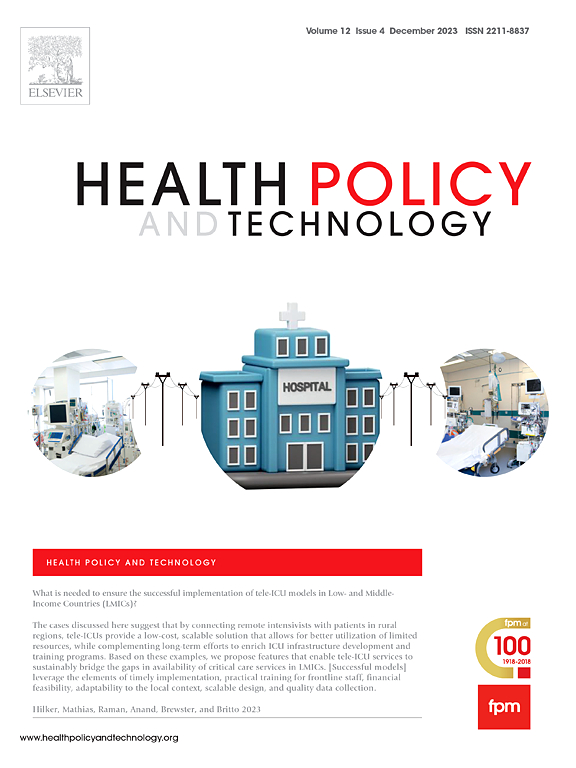将人工智能引入OpenNotes以及对话的前景
IF 3.7
3区 医学
Q1 HEALTH POLICY & SERVICES
引用次数: 0
摘要
opennotes是一个允许患者及其护理人员查看和修改病例记录的平台。通过这种策略,临床过程将是透明的,这些人之间可以建立信任。本文的目的是阐明OpenNotes在此过程中引入人工智能可能产生的问题。伴随这一变化的是在案例记录的制作中引入了以技术为媒介的交流。方法对技术媒介的沟通以及这种交互模式对OpenNotes努力培养的协作关系的影响进行了检查。结果技术介导的沟通显著改变了相互作用,从而改变了临床环境。特别重要的是,客户可能会被这种技术吓倒,对客户的询问可能会给出不充分的回应,语言使用可能会过度简化,自动化可能需要标准化,从而扭曲患者与护理人员的对话。人工智能的引入可能会破坏OpenNotes旨在改善临床环境的信任。如果使用OpenNotes的支持者不小心,病人与护理者的互动可能会变成事务性的。采用人工智能的匆忙应该有所缓和,这样这项技术对病人和护理者对话的影响就可以得到严格的评估。本文章由计算机程序翻译,如有差异,请以英文原文为准。
The introduction of AI into OpenNotes and the prospects for dialogue
Objectives
OpenNotes is a platform that allows patients and their caregivers to both review and modify case notes. Through this strategy the clinical process will be transparent and trust can be established between these persons. The aim of this paper is to shed some light on the problems that may arise from OpenNotes introducing AI into this process. Accompanying this change is the introduction of technologically mediated communication into the production of case notes.
Methods
An examination was conducted of technologically mediated communication and the impact of this mode of interaction on the collaborative relationship that OpenNotes strives to foster.
Results
Technologically mediated communication modifies significantly interaction, thereby altering the clinical setting. Specifically important is that clients may be intimidated by this technology, inadequate responses may be given to client inquiries, language use may be overly simplified, and automation may require standardization that distorts patient-caregiver dialogue.
Conclusions
The introduction of AI may undermine the trust that OpenNotes is designed to improve in the clinical setting. Patient-caregiver interaction may become transactional, if proponents of using in OpenNotes are not careful. The rush to adopting AI should be tempered, so that the impact of this technology on patient-caregiver dialogue can be critically assessed.
求助全文
通过发布文献求助,成功后即可免费获取论文全文。
去求助
来源期刊

Health Policy and Technology
Medicine-Health Policy
CiteScore
9.20
自引率
3.30%
发文量
78
审稿时长
88 days
期刊介绍:
Health Policy and Technology (HPT), is the official journal of the Fellowship of Postgraduate Medicine (FPM), a cross-disciplinary journal, which focuses on past, present and future health policy and the role of technology in clinical and non-clinical national and international health environments.
HPT provides a further excellent way for the FPM to continue to make important national and international contributions to development of policy and practice within medicine and related disciplines. The aim of HPT is to publish relevant, timely and accessible articles and commentaries to support policy-makers, health professionals, health technology providers, patient groups and academia interested in health policy and technology.
Topics covered by HPT will include:
- Health technology, including drug discovery, diagnostics, medicines, devices, therapeutic delivery and eHealth systems
- Cross-national comparisons on health policy using evidence-based approaches
- National studies on health policy to determine the outcomes of technology-driven initiatives
- Cross-border eHealth including health tourism
- The digital divide in mobility, access and affordability of healthcare
- Health technology assessment (HTA) methods and tools for evaluating the effectiveness of clinical and non-clinical health technologies
- Health and eHealth indicators and benchmarks (measure/metrics) for understanding the adoption and diffusion of health technologies
- Health and eHealth models and frameworks to support policy-makers and other stakeholders in decision-making
- Stakeholder engagement with health technologies (clinical and patient/citizen buy-in)
- Regulation and health economics
 求助内容:
求助内容: 应助结果提醒方式:
应助结果提醒方式:


